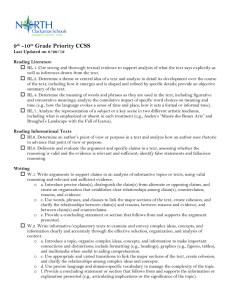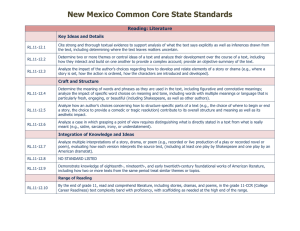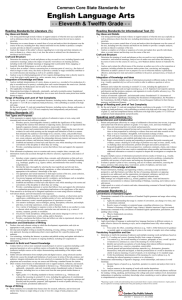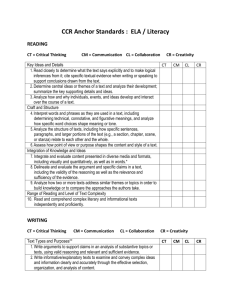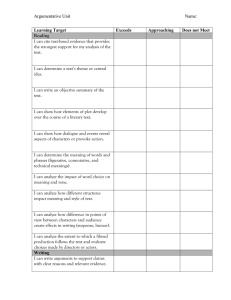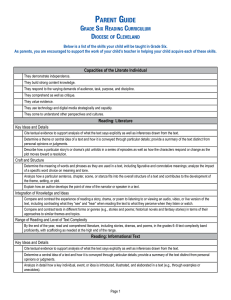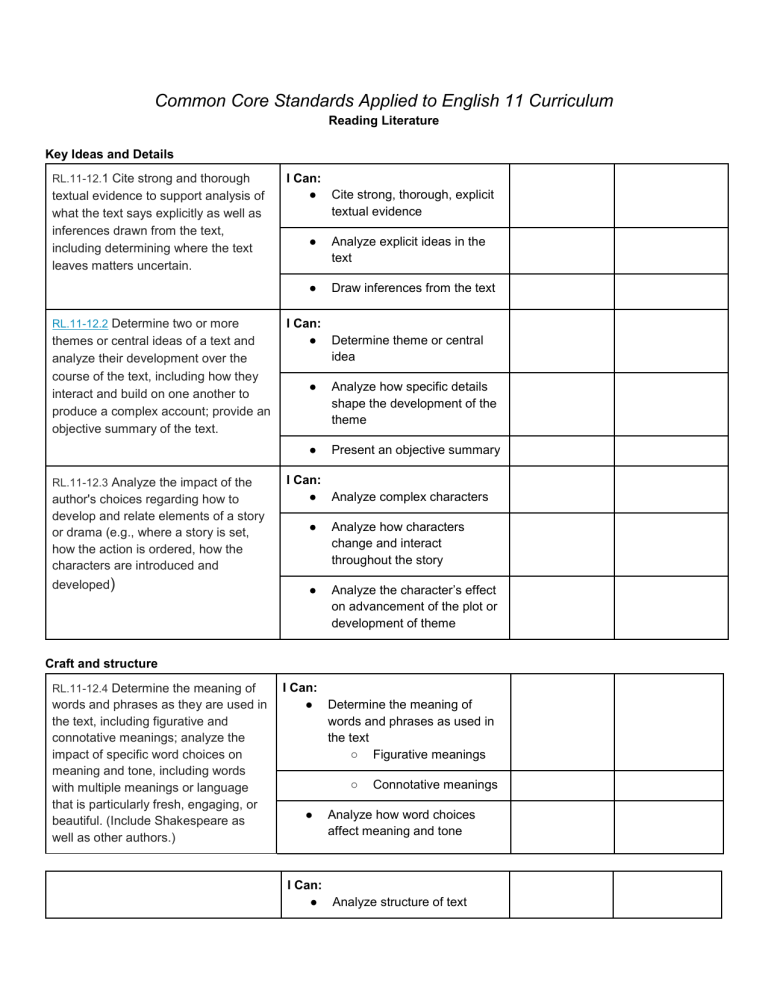
Common Core Standards Applied to English 11 Curriculum Reading Literature Key Ideas and Details RL.11-12.1 Cite strong and thorough textual evidence to support analysis of what the text says explicitly as well as inferences drawn from the text, including determining where the text leaves matters uncertain. RL.11-12.2 Determine two or more themes or central ideas of a text and analyze their development over the course of the text, including how they interact and build on one another to produce a complex account; provide an objective summary of the text. RL.11-12.3 Analyze the impact of the author's choices regarding how to develop and relate elements of a story or drama (e.g., where a story is set, how the action is ordered, how the characters are introduced and developed) I Can: ● Cite strong, thorough, explicit textual evidence ● Analyze explicit ideas in the text ● Draw inferences from the text I Can: ● Determine theme or central idea ● Analyze how specific details shape the development of the theme ● Present an objective summary I Can: ● Analyze complex characters ● Analyze how characters change and interact throughout the story ● Analyze the character’s effect on advancement of the plot or development of theme Craft and structure RL.11-12.4 Determine the meaning of words and phrases as they are used in the text, including figurative and connotative meanings; analyze the impact of specific word choices on meaning and tone, including words with multiple meanings or language that is particularly fresh, engaging, or beautiful. (Include Shakespeare as well as other authors.) I Can: ● Determine the meaning of words and phrases as used in the text ○ Figurative meanings ○ ● Connotative meanings Analyze how word choices affect meaning and tone I Can: ● Analyze structure of text RL.11-12.5 Analyze how an author's choices concerning how to structure specific parts of a text (e.g., the choice of where to begin or end a story, the choice to provide a comedic or tragic resolution) contribute to its overall structure and meaning as well as its aesthetic impact. RL.11-12.6 Analyze a case in which grasping a point of view requires distinguishing what is directly stated in a text from what is really meant (e.g., satire, sarcasm, irony, or understatement). ● Analyze order of events ● Examine author’s manipulation of time and its effect ● Understand parallel plot ● Understand flashback I Can: ● Analyze a point of view taking into account cultural experiences of a character ● Read a wide range of literature from around the world Integration of Knowledge and Ideas RL.11-12.7 Analyze multiple interpretations of a story, drama, or poem (e.g., recorded or live production of a play or recorded novel or poetry), evaluating how each version interprets the source text. (Include at least one play by Shakespeare and one play by an American dramatist.) I Can: ● Compare and contrast the representation of a subject in two different mediums ○ Reading ○ Play ○ Movie(s) RL.8 - (Not applicable to literature) L.11-12.9 Demonstrate knowledge of eighteenth-, nineteenth- and earlytwentieth-century foundational works of American literature, including how two or more texts from the same period treat similar themes or topics. I Can: ● Define allusion ● Identify an author’s use of an allusion ● Analyze how the author transforms the allusion in the studied work Range of Reading and Level of Text Complexity RL.9-10.10. By the end of grade 9, read and comprehend literature, including stories, dramas, and poems, in the grades 9–10 text complexity band proficiently, with scaffolding as needed at the high end of the range. I Can: ● Comprehend many genres of literature at my grade level By the end of grade 10, read and comprehend literature, including stories, dramas, and poems, at the high end of the grades 9–10 text complexity band independently and proficiently. Reading Informational Text Key Ideas and Details RI.11-12.1 Cite strong and thorough textual evidence to support analysis of what the text says explicitly as well as inferences drawn from the text, including determining where the text leaves matters uncertain. RI.11-12.2 Determine two or more central ideas of a text and analyze their development over the course of the text, including how they interact and build on one another to provide a complex analysis; provide an objective summary of the text. I Can: ● Cite strong, thorough, explicit textual evidence ● Analyze explicit ideas in the text ● Draw inferences from the text I Can: ● Determine central idea ● Cite supporting details and analyze how the central idea emerges and is shaped by those details ● RI.11-12.3 Analyze a complex set of ideas or sequence of events and explain how specific individuals, ideas, or events interact and develop over the course of the text. Present an objective summary I Can: ● Analyze structure of text ● Analyze order of events or series of ideas ● Analyze main points and the connections drawn from them Craft and structure RI.11-12.4 Determine the meaning of words and phrases as they are used in a text, including figurative, connotative, and technical meanings; analyze how an author uses and refines the meaning of a key term or terms over the course of a text (e.g., how Madison defines faction in Federalist No. 10). . I Can: ● Determine the meaning of words and phrases as used in the text ○ Figurative meanings ○ Connotative meanings ○ Technical meanings , ● RI.11-12.5 Analyze and evaluate the effectiveness of the structure an author uses in his or her exposition or argument, including whether the structure makes points clear, convincing, and engaging. RI.11-12.6 Determine an author's point of view or purpose in a text in which the rhetoric is particularly effective, analyzing how style and content contribute to the power, persuasiveness or beauty of the text. Analyze how word choices affect the overall meaning and tone I Can: ● Examine an author’s development of claims or ideas ● Determine how ideas or claims are refined by particular parts of the text I Can: ● Determine point of view ● Determine purpose ● Define rhetoric ● Analyze how the author uses rhetoric to advance point of view or purpose Integration of Knowledge and Ideas RI.11-12.7 Integrate and evaluate multiple sources of information presented in different media or formats (e.g., visually, quantitatively) as well as in words in order to address a question or solve a problem. RI.11-12.8 Delineate and evaluate the reasoning in seminal U.S. texts, including the application of constitutional principles and use of legal reasoning (e.g., in U.S. Supreme Court majority opinions and dissents) and the premises, purposes, and arguments in works of public advocacy (e.g., The Federalist, presidential addresses). I Can: ● Compare and contrast the representation of a subject from two different mediums ● Analyze various accounts to determine which details are emphasized I Can: ● Define fallacious reasoning ● Delineate the specific claims ● Assess valid reasoning ● Identify false statements ● Identify fallacious reasoning I Can: ● Define seminal RI.11-12.9 Analyze seventeenth-, eighteenth-, and nineteenth-century foundational U.S. documents of historical and literary significance (including The Declaration of Independence, the Preamble to the Constitution, the Bill of Rights, and Lincoln's Second Inaugural Address) for their themes, purposes, and rhetorical features. ● Analyze significant historical and literary documents ● Analyze how the documents address related themes and concepts Range of Reading and Level of Text Complexity RI.9-10.10. By the end of grade 9, read and comprehend literary nonfiction in the grades 9–10 text complexity band proficiently, with scaffolding as needed at the high end of the range. I Can: ● Comprehend nonfiction writing at my grade level By the end of grade 10, read and comprehend literary nonfiction at the high end of the grades 9–10 text complexity band independently and proficiently. Writing Text Types and Purposes W.11-12.1 Write arguments to support claims in an analysis of substantive topics or texts, using valid reasoning and relevant and sufficient evidence. I Can: ● Write an argument to support a claim (thesis) ● Introduce a precise claim ● Distinguish claim from alternate or opposing claims ● Clearly organize relationships among claim(s), counterclaims, reasons and evidence ● Use evidence to support claim(s) and counterclaims fairly W.11-12.1.A Introduce precise, knowledgeable claim(s), establish the significance of the claim(s), distinguish the claim(s) from alternate or opposing claims, and create an organization that logically sequences claim(s), counterclaims, reasons, and evidence. W.11-12.1.B Develop claim(s) and counterclaims fairly and thoroughly, supplying the most relevant evidence for each while pointing out the strengths and limitations of both in a manner that anticipates the audience's knowledge level, concerns, values, and possible biases. ● Adapt claim(s) and counterclaims to audience’s knowledge level and concerns W.11-12.1.C Use words, phrases, and ● Use transitions to create cohesion between claim(s) and reasons, reasons and evidence, and claim(s) and counterclaims. ● Use objective tone ● Attend to norms and conventions of the subject area in which they are writing ● Provide a concluding section ● Write an informative/ explanatory text ● Organize complex ideas ● Make important connections ● Format graphics to enhance writing ● Choose sufficient facts, extended definitions, etc. appropriate to audience’s knowledge of topic ● Use varied transitions to link major sections of the text W.11-12.2.B Develop the topic thoroughly ● by selecting the most significant and relevant facts, extended definitions, concrete details, quotations, or other information and examples appropriate to the audience's knowledge of the topic. Manage the complexity of the topic using precise language ● Use an objective tone while maintaining a formal style true to the mode of writing W.11-12.2.C Use appropriate and varied ● Write a conclusion which articulates the topic’s significance clauses as well as varied syntax to link the major sections of the text, create cohesion, and clarify the relationships between claim(s) and reasons, between reasons and evidence, and between claim(s) and counterclaims W.11-12.1.D Establish and maintain a formal style and objective tone while attending to the norms and conventions of the discipline in which they are writing. W.11-12.1.E Provide a concluding statement or section that follows from and supports the argument presented. W.11-12.2 Write informative/explanatory texts to examine and convey complex ideas, concepts, and information clearly and accurately through the effective selection, organization, and analysis of content. W.11-12.2.A Introduce a topic; organize complex ideas, concepts, and information so that each new element builds on that which precedes it to create a unified whole; include formatting (e.g., headings), graphics (e.g., figures, tables), and multimedia when useful to aiding comprehension. transitions and syntax to link the major sections of the text, create cohesion, and clarify the relationships among complex ideas and concepts. W.11-12.2.D Use precise language, domain-specific vocabulary, and techniques such as metaphor, simile, and analogy to manage the complexity of the topic. W.11-12.2.E Establish and maintain a formal style and objective tone while attending to the norms and conventions of the discipline in which they are writing. W.11-12.2.F Provide a concluding statement or section that follows from and supports the information or explanation presented (e.g., articulating implications or the significance of the topic). W.11-12.3 Write narratives to develop real or imagined experiences or events using effective technique, well-chosen details, and well-structured event sequences. I Can: ● Write a narrative ● Create conflict ● Use multiple strategies to organize information ● Establish points of view ● Introduce narrator and/or in characters in exposition ● Create a smooth progression of experiences and events ● to sequence events so that they build on one another to create a coherent whole and build toward a particular tone and outcome (e.g., a sense of mystery, suspense, growth, or resolution). Sequence events building on a variety of techniques to create a coherent whole ● Use vivid details to create a clear picture, setting, and characters W.11-12.3.D Use precise words and ● Provide a conclusion that resolves and reflects the experience W.11-12.3.A Engage and orient the reader by setting out a problem, situation, or observation and its significance, establishing one or multiple point(s) of view, and introducing a narrator and/or characters; create a smooth progression of experiences or events. W.11-12.3.B Use narrative techniques, such as dialogue, pacing, description, reflection, and multiple plot lines, to develop experiences, events, and/or characters. W.11-12.3.C Use a variety of techniques phrases, telling details, and sensory language to convey a vivid picture of the experiences, events, setting, and/or characters. .W.11-12.3.E Provide a conclusion that follows from and reflects on what is experienced, observed, or resolved over the course of the narrative. Production and Distribution W.11-12.4 Produce clear and coherent writing in which the development, organization, and style are appropriate to task, purpose, and audience. (Gradespecific expectations for writing types are defined in standards 1-3 above.) W.11-12.5 Develop and strengthen writing as needed by planning, revising, editing, rewriting, or trying a new approach, focusing on addressing what is most significant for a specific purpose and audience. (Editing for conventions should demonstrate command of Language standards 1-3 up to and including grades 11-12 here.) W.11-12.6 Use technology, including the Internet, to produce, publish, and update individual or shared writing products in response to ongoing feedback, including new arguments or information. I Can: ● Develop grade-level appropriate writing I Can: ● Use revision strategies ● Use editing strategies ● Focus on what is most significant for purpose and audience I Can: ● Use technology to publish writing ● Update individual or shared writing products with tech. ● Link to other information in document with technology ● Display information flexibly and dynamically with tech. Research to Build and Present Knowledge W.11-12.7 Conduct short as well as more sustained research projects to answer a question (including a self-generated question) or solve a problem; narrow or broaden the inquiry when appropriate; I Can: ● Conduct a sustained research project ● Focus an inquiry on a problem or question synthesize multiple sources on the subject, demonstrating understanding of the subject under investigation. W.11-12.8 Gather relevant information from multiple authoritative print and digital sources, using advanced searches effectively; assess the strengths and limitations of each source in terms of the task, purpose, and audience; integrate information into the text selectively to maintain the flow of ideas, avoiding plagiarism and overreliance on any one source and following a standard format for citation. W.11-12.9 Draw evidence from literary or informational texts to support analysis, reflection, and research. W.11-12.9.A Apply grades 11-12 Reading standards to literature (e.g., "Demonstrate knowledge of eighteenth-, nineteenth- and early-twentieth-century foundational works of American literature, including how two or more texts from the same period treat similar themes or topics"). W.11-12.9.B Apply grades 11-12 Reading standards to literary nonfiction (e.g., "Delineate and evaluate the reasoning in seminal U.S. texts, including the application of constitutional principles and use of legal reasoning [e.g., in U.S. Supreme Court Case majority opinions and dissents] and the premises, purposes, and ● Solve a problem ● Synthesize multiple sources ● Demonstrate understanding of subject by solving a problem or answering a question I Can: ● Find authoritative information from print sources ● Find information from advanced databases and/or other digital sources ● Avoid plagiarism by using correct citations and following a standard format ● Decide if a source is valid ● Integrate information into the text to maintain a flow of ideas ● Produce a bibliography I Can: ● Support an analysis, reflection, and research with evidence from literary or informational texts. arguments in works of public advocacy [e.g., The Federalist, presidential addresses]"). Range of Writing W.11-12.10. Write routinely over extended time frames (time for research, reflection, and revision) and shorter time frames (a single sitting or a day or two) for a range of tasks, purposes, and audiences. I Can: ● Write for many reasons for a variety of audiences. Speaking and Listening Comprehension and Collaboration SL.11-12.1 Initiate and participate effectively in a range of collaborative discussions (one-on-one, in groups, and teacher-led) with diverse partners on grades 11-12 topics, texts, and issues, building on others' ideas and expressing their own clearly and persuasively. I Can: ● Participate in one-on-one discussions ● Participate in group discussions ● Participate in teacher-led discussions ● Prepare for a discussion ● Follow rules for discussions ● Ask questions of my group members ● Respond to questions posed by my group members ● Summarize the group’s discussion ● Understand others’ perspectives SL.11-12.1.A Come to discussions prepared, having read and researched material under study; explicitly draw on that preparation by referring to evidence from texts and other research on the topic or issue to stimulate a thoughtful, well-reasoned exchange of ideas. .SL.11-12.1.B Work with peers to promote civil, democratic discussions and decision-making, set clear goals and deadlines, and establish individual roles as needed. SL.11-12.1.C Propel conversations by posing and responding to questions that probe reasoning and evidence; ensure a hearing for a full range of positions on a topic or issue; clarify, verify, or challenge ideas and conclusions; and promote divergent and creative perspectives. SL.11-12.1.D Respond thoughtfully to diverse perspectives; synthesize comments, claims, and evidence made on all sides of an issue; resolve contradictions when possible; and determine what additional information or research is required to deepen the investigation or complete the task. SL.11-12.2 Integrate multiple sources of information presented in diverse formats and media (e.g., visually, quantitatively, orally) in order to make informed decisions and solve problems, evaluating the credibility and accuracy of each source and noting any discrepancies among the data. SL.11-12.3 Evaluate a speaker's point of view, reasoning, and use of evidence and rhetoric, assessing the stance, premises, links among ideas, word choice, points of emphasis, and tone used. I Can: ● Understand information presented in various formats ● Explain its value or purpose I Can: ● Define delineate ● Tell the difference between supported and unsupported claims Presentation of Knowledge and Ideas SL.11-12.4 Present information, findings, and supporting evidence, conveying a clear and distinct perspective, such that listeners can follow the line of reasoning, alternative or opposing perspectives are addressed, and the organization, development, substance, and style are appropriate to purpose, audience, and a range of formal and informal tasks. SL.11-12.5 Make strategic use of digital media (e.g., textual, graphical, audio, visual, and interactive elements) in presentations to enhance understanding of findings, reasoning, and evidence and to add interest. I Can: ● Present claims logically ● Use descriptions, facts, and details ● Use appropriate eye contact, volume and pronunciation I Can: ● Use multimedia components in a presentation .SL.11-12.6 Adapt speech to a variety of contexts and tasks, demonstrating a command of formal English when indicated or appropriate. (See grades 11-12 Language standards 1 and 3 here for specific expectations.) I Can: ● Use formal language in a classroom setting Language Conventions of Standard English L.11-12.1 Demonstrate command of the conventions of standard English grammar and usage when writing or speaking. L.11-12.1.A Apply the understanding that usage is a matter of convention, can change over time, and is sometimes contested. L.11-12.1.B Resolve issues of complex or contested usage, consulting references (e.g., Merriam-Webster's Dictionary of English Usage, Garner's Modern American Usage) as needed. .L.11-12.2 Demonstrate command of the conventions of standard English capitalization, punctuation, and spelling when writing. I Can: ● Demonstrate proper usage of the eight parts of speech in writing and speaking ● Use pronouns in the proper case ● Use intensive pronouns ● Correct inappropriate use of pronouns ● Correct unclear pronouns ● Find and correct mistakes in own and others’ writing and speaking I Can: ● Use capitalization and punctuation correctly. ● Define nonrestrictive elements Peer and SelfReview on formal essays Essays L.11-12.2.A ● Define parenthetical elements ● Use punctuation with nonrestrictive and parenthetical elements ● Spell correctly Observe hyphenation conventions. L.11-12.2.B Spell correctly. Knowledge of Language L.11-12.3 Apply knowledge of language to understand how language functions in different contexts, to make effective choices for meaning or style, and to comprehend more fully when reading or listening. L.11-12.3.A Vary syntax for effect, I Can: ● Use proper conventions ● Use varying sentence patterns ● Remain consistent in style and tone consulting references (e.g., Tufte's Artful Sentences) for guidance as needed; apply an understanding of syntax to the study of complex texts when reading. Vocabulary Acquisition and Use L.11-12.4 Determine or clarify the meaning of unknown and multiplemeaning words and phrases based on grades 11-12 reading and content, choosing flexibly from a range of strategies. .L.11-12.4.A Use context (e.g., the overall meaning of a sentence, paragraph, or text; a word's position or function in a sentence) as a clue to the meaning of a word or phrase. L.11-12.4.B Identify and correctly use patterns of word changes that indicate different meanings or parts of speech (e.g., conceive, conception, conceivable). L.11-12.4.C Consult general and specialized reference materials (e.g., dictionaries, glossaries, thesauruses), I Can: ● Use context clues to determine the meaning of a word ● Use Greek or Latin roots to determine the meaning of a word ● Use print reference materials ● Use electronic reference materials both print and digital, to find the pronunciation of a word or determine or clarify its precise meaning, its part of speech, its etymology, or its standard usage. L.11-12.4.D Verify the preliminary determination of the meaning of a word or phrase (e.g., by checking the inferred meaning in context or in a dictionary). .L.11-12.5 Demonstrate understanding of figurative language, word relationships, and nuances in word meanings. I Can: ● Use figurative language ○ Similes ○ Metaphors L.11-12.5.A Interpret figures of speech ○ Personification (e.g., hyperbole, paradox) in context and analyze their role in the text. ○ Idioms ○ Allusion ○ Oxymoron ○ Others: L.11-12.5.B Analyze nuances in the meaning of words with similar denotations. ● .L.11-12.6 Acquire and use accurately general academic and domain-specific words and phrases, sufficient for reading, writing, speaking, and listening at the college and career readiness level; demonstrate independence in gathering vocabulary knowledge when considering a word or phrase important to comprehension or expression. Find relationships between words to better understand them I Can: ● Use grade-appropriate vocabulary Weekly Vocabulary Lessons and Quizzes, Contentappropriate Vocabulary
